India’s housing sector, while appearing robust with record sales, faces an underlying challenge of slowing growth and uneven demand, primarily favoring the premium segment.
A “Boom” That’s Not For Everyone
On the surface, India’s housing market seems to be flourishing, with home sales hitting a 12-year high of 3.5 lakh units in 2024. However, this impressive figure masks a significant disparity: most of this growth stems from the premium segment, indicating a market increasingly catering to the wealthy.
This trend highlights a growing divide, where homeownership becomes an elusive dream for a large portion of the population. The market is not expanding evenly, raising questions about its long-term sustainability and inclusivity.
Developers Double Down on Luxury
Despite Sales Dip, Premium Focus Remains
Even as overall sales in India’s top seven cities saw a 24 percent year-on-year drop in the first half of 2025, and new launches fell by 13 percent, developers continue to push premium properties. According to real estate firm Anarock, the share of new launches priced above Rs 1.5 crore rose to 46 percent in April-June, up from 43 percent in the previous quarter.
Meanwhile, the supply of affordable homes, those priced below Rs 40 lakh, held steady at just 12 percent. This “K-shaped growth” means supply is heavily tilted towards the upper end, leaving fewer options for budget-conscious buyers.
The Affordability Hurdle
While the Reserve Bank of India’s (RBI) repo rate cuts in 2025 have slightly improved affordability metrics, this gain has been largely nullified by rising property prices. Cities like Kolkata, Chennai, and Ahmedabad have seen particularly sharp increases.
For instance, Mumbai’s affordability index improved, yet a homeowner still needs to spend 48 percent of their income on EMI, just shy of Knight Frank’s “unaffordable” threshold of 50 percent. Smaller cities are also experiencing faster price jumps, making housing less accessible.
A Buyer’s Market for the Elite
Although homes priced below Rs 1 crore still accounted for over half of sales in early 2025, their share is decreasing. This shift in supply has led to a significant build-up of high-end and luxury inventory, which now makes up 52 percent of the total housing stock.
Conversely, homes priced under Rs 40 lakh comprise only a fifth of the available stock. Buyer sentiment reflects this imbalance, with property platform Magicbricks reporting a fall in its Housing Sentiment Index, especially for lower-income segments.
Policymakers Voice Concern Over Weakening Demand
The slowdown in housing demand is now a concern for policymakers. Home loan growth has decelerated significantly, rising 13.8 percent year-on-year by May 2025, compared to 19.9 percent a year prior (excluding the HDFC Bank merger impact).
An external member of the RBI’s Monetary Policy Committee noted that urban demand for housing and other interest-rate sensitive goods is not at desired levels, impacting private investment. This indicates a broader economic concern, beyond just the real estate sector.
- India’s housing growth is largely concentrated in the premium segment, creating a market divide.
- Developers are pushing luxury homes despite a drop in overall sales and new launches.
- Rising property prices are negating the benefits of interest rate cuts, impacting affordability.
- Home loan growth has slowed, signalling weakening demand and raising concerns among policymakers.
The current trends suggest that while headline figures may look impressive, the housing market’s uneven growth points to deeper challenges in overall consumer demand and economic recovery.














